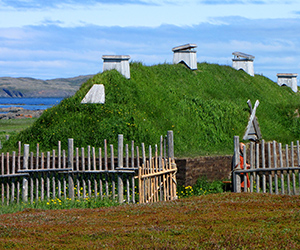CANADA HISTORY
Royal Visit

In March 1939, Germany's occupation of Czechoslovakia signaled the collapse of the policy of appeasement. For much of the 1930s, European leaders, particularly in Britain and France, had hoped that by allowing Hitler to annex certain territories—first Austria, then the Sudetenland—war could be averted. However, the occupation of the rest of Czechoslovakia proved that Hitler’s ambitions went beyond mere territorial adjustments. It became clear that he sought domination over much of Europe, and war seemed imminent. Against this tense backdrop of looming conflict, an event of profound importance was set to unfold in Canada: the Royal Visit of King George VI and Queen Elizabeth.
The visit was monumental for several reasons. It was the first time a reigning British monarch had visited Canada, which was a significant milestone in the evolution of the Dominion’s relationship with the British Empire. King George VI and Queen Elizabeth’s tour of Canada in May 1939 had been planned well before the situation in Europe reached its boiling point. Initially intended to strengthen the already strong bonds between Canada and Britain, it became far more than a mere gesture of goodwill by the time the Royal couple arrived. The visit took on new meaning as it became a symbol of unity within the Commonwealth, a demonstration of Canada’s status as an independent kingdom, and a subtle political maneuver aimed at drawing the United States closer to the Allied cause in the face of growing fascist aggression.
The Royal visit officially began on May 17, 1939, when King George VI and Queen Elizabeth arrived in Quebec City aboard the RMS Empress of Australia, a Canadian Pacific vessel. Their arrival was a spectacle of charm and diplomacy, especially in Quebec, where French Canadians—who had historically been ambivalent, if not outright skeptical, of their ties to Britain—were charmed by the Royal couple’s efforts to speak fluent French. This was more than a diplomatic gesture; it represented an effort to unify a country that was still divided along cultural and linguistic lines. The visit to Quebec set the tone for the entire tour: the King and Queen were not just visiting as British monarchs but as the King and Queen of Canada.
This was a crucial distinction, and the visit was designed to demonstrate Canada’s evolving identity as an independent nation under the Statute of Westminster, passed in 1931. The statute had legally established the autonomy of Canada and other dominions, giving them full legislative independence from Britain. While ties to the monarchy remained strong, Canada had its own distinct political identity. The Royal visit, therefore, was more than a ceremonial tour; it underscored the constitutional independence of Canada, even as it maintained its status within the British Commonwealth. King George VI was not just a British monarch visiting a colony; he was the sovereign of an independent Canada. This subtle shift in the dynamics of monarchy and dominion would resonate with Canadians for years to come.
From Quebec, the King and Queen traveled to Ottawa, where Queen Elizabeth laid the cornerstone for the new Supreme Court of Canada building. This act symbolized the importance of Canadian law and governance being administered separately from British control. It was another moment that emphasized Canada’s independent legal framework. Meanwhile, King George VI participated in the dedication of the National War Memorial, a powerful symbol of Canada’s contributions and sacrifices in World War I. The dedication, which took place in front of Parliament, was a moment of great national pride and poignancy, particularly for the war veterans who attended. Queen Elizabeth’s decision to walk among the veterans and engage them in conversation demonstrated a deep empathy that endeared her to Canadians and solidified the Royal couple’s connection to the people.
The visit was meticulously planned to highlight the idea that King George VI and Queen Elizabeth were the King and Queen of Canada, not simply emissaries of Britain. At Parliament, the King gave Royal Assent to several bills, performing his role as Canada’s official Head of State. The event was both symbolic and practical, showcasing how Canada’s government functioned independently while retaining the ceremonial aspects of the monarchy. This was a delicate balance, but the tour made it clear that Canada’s ties to Britain were evolving into a relationship based on shared history and common values, rather than direct political control.
As the Royal tour progressed, the King and Queen crossed the country, traveling through cities and towns from coast to coast. In each place, they were greeted by enthusiastic crowds, and their ability to connect with Canadians across different regions and cultures became a central feature of the tour’s success. Royal visits had always been popular, but this tour was different: it occurred during a time of international uncertainty and rising tensions. It served to reinforce national unity and bolster the Canadian spirit as war clouds gathered over Europe.
One of the unspoken goals of the Royal visit was to demonstrate the strength of the Commonwealth in the face of the growing fascist threat posed by Germany and Italy. The tour subtly projected the message that Canada, as part of the Commonwealth, was not isolated but was part of a broader, global alliance. The timing of the tour, just months before the outbreak of World War II, emphasized the importance of solidarity between Canada and Britain. As Canada prepared for the possibility of war, the Royal visit served as a reminder of the country’s shared values with Britain and the Commonwealth, including democracy, freedom, and resistance to totalitarianism.
The importance of the Royal visit extended beyond Canadian borders. Following the Canadian tour, King George VI and Queen Elizabeth traveled to the United States for a historic visit, the first by a reigning British monarch. While the official visit took place from June 7 to 10, 1939, its importance was monumental. The U.S. had long maintained a stance of isolationism, particularly following the devastation of World War I. President Franklin D. Roosevelt had been seeking ways to bring the U.S. closer to the Allied cause without directly challenging the strong current of isolationist sentiment in the country. The visit by the King and Queen of Canada helped shift public opinion in the U.S. by presenting the Royal family not as distant British figures but as part of a North American alliance. The tour helped reinforce Roosevelt’s belief that the U.S. should support Britain and its allies in the coming conflict.
The Royal visit to Canada and the United States succeeded on all fronts. In Canada, it unified the country at a time of global uncertainty and demonstrated the monarchy’s role in Canadian society. In the United States, it fostered goodwill and laid the groundwork for stronger diplomatic ties between the two nations, which would prove invaluable once World War II erupted. The visit also set the stage for Canada's entry into the war, which would come in September 1939 when Canada declared war on Germany, independently of Britain, just one week after the United Kingdom’s declaration.
In Canadian history, the 1939 Royal Tour stands as a pivotal event. It symbolized Canada’s growing autonomy within the Commonwealth, its unity as a nation, and its readiness to face the challenges of a world at war. It also highlighted the enduring strength of the monarchy in Canadian life, even as the country moved towards a more distinct national identity. The visit is remembered as one of the defining moments that helped shape Canada’s role in World War II and in the broader Commonwealth, affirming the country's place in the global struggle against fascism and totalitarianism.
Cite Article : www.canadahistory.com/sections/documents




